M. Rezig , K. Srairi , L. Aloui
Department of Electrical Engineering, University of Biskra, Algeria
Correspondence to: M. Rezig , Department of Electrical Engineering, University of Biskra, Algeria.
| Email: |  |
Copyright © 2012 Scientific & Academic Publishing. All Rights Reserved.
Abstract
This paper presents an optimal geometric design of a method for induction heating system. The objective of this design is to obtain a desired optimal distribution temperature in the load. The dimensions of the inductors are taken as design parameters and are replaced at each iterative step, using the bisection method to minimize the error of the calculated temperature and the desired one in each node. The study of such a device requires the use of models or modeling, physical, mathematical and numerical. Representation this modeling is the basis of the understanding, design and optimization of these systems. The optimization technique is to find values of variables that maximize or minimize the objective function.
Keywords:
Numerical Methods, Induction Heating Systems, Geometrical Optimization, Electromagnetic and Thermal Coupling
Cite this paper:
M. Rezig , K. Srairi , L. Aloui , "Modeling and Optimization of a Goemetrique Induction Cooking for Improving the Temperature", International Journal of Materials Engineering , Vol. 1 No. 1, 2011, pp. 17-20. doi: 10.5923/j.ijme.20110101.02.
1. Introduction
Through the researches achieved in the last twenty years, many industrial processes requiring heating operations make use of induction heating devices. Many industrial applications have been developed, surface heat treatment, forging, bonding by polymerization, domestic and household applications.ListenRead phoneticallyHowever, the development of heating equipment induction is not easy. The inductors are still often dimensioned empirically, based on the experience gained by the manufacturer, and the power profile to be injected into the part (pan), obtained by trial and error. However, the tests are long and costly. Also computer-aided design, based on numerical simulation of magnetic and thermal phenomena involved, has certain advantages in terms of cost, time and optimization for the development of induction heating processes. The prediction of magneto-thermal behavior of the whole work space - inductor allows the optimization of both electrical and mechanical design of the inductor, and also the necessary power required to treat the work space.The temperature distribution is itself a key factor for predicting the effectiveness of heat treatment; physical properties of materials are strongly temperature dependent.For nonlinear problems with complex geometry, the finite volume method developed in recent years, considered as animportant tool for modeling many branches of engineering, in fluid mechanics, heat transfer, electromagnetism etc. The mathematical analysis of the finite volume method has also helped engineers to develop the basic principles that make it an efficient tool of discretization.Numerical modeling of problems involving multi-physics coupling is now a major area of research. A good comprehension of the phenomena requires passing through an important phase which is an efficient physical modeling and numerical problems.The design optimization of induction heating process is classified within this type of approach. The methods of heating induction is by nature a good example of coupling multi-physics (electromagnetism, thermal-mechanical and metallurgical).
2. Mathematical Modelling
The physical modeling of induction heating involves both magneto dynamic equations and heat equations, this first stage based mathematical formulation is useful to determine the magnetic field created by the inductor in the surrounding space, to deduce the induced currents and local power dissipated by Joule effect in the conducting part to be heated, then in the second phase the dissipated power considered as a heat source to begin the calculation the temperature.ListenRead phoneticallyThe magneto dynamic equations are derived from Maxwell's equations and constitutive laws of materials. The equation of heat diffusion is governed by the Fourier law. These equations are written in the case of the AV formulation related to the magneto dynamic problem.A mathematical model of induction heating incorporating coupled multi-physics must assure the coupling of the following equations:• Maxwell's equations — to access to the currents induced in the specified part;• The equation of heat — to model the thermal evolution due to the power dissipated by the currents induced in the part (piece).
2.1. Electromagnetic Model
The electromagnetic problem is modelled using the four Maxwell's equations (with the approximation of the quasi- permanent modes), with the relation between the magnetic field induction B and the magnetic field H, and the traditional law Maxwell's equations of Ohm; for an axisymmetric configuration, a judicious combination of the preceding equations leads, recall that the magneto-dynamic equation in the case or the load is motionless compared to the inductor | (1) |
2.2. Thermal Model
The change of the temperature is primarily controlled by the power dissipated by the induced currents. The equation of heat is thus written below : | (2) |
Where the source term comes from the powers dissipated by joule effect.
3. Optimization Problem Formulation
Optimization is often summarized with the mathematical techniques of resolution to which one charges the failures thereafter that one meets. However, as for the majority of the problems which one is brought to solve, optimization must be the systematic step object which involves four fundamental phases summarized in Figure 1. | Figure 1. Fundamental Phases Summarized |
3.1. Problem Presentation
It is an optimal design of our device (cooking with induction), which takes account of the experimental model. The analysis into the sensitivity of the geometry of the model by the bisection method is applied like an algorithm of optimization to solve the problems of the device with induction.The optimization problem can be formulated as the following: | (3) |
Wheref(x) = e Such as The function  | (4) |
The suggested method is applied has induction heating with pan like numerical example to order the optimal temperature of the device, the density of current the positions of the inductor and are snuff like parameters of design and the latter will be replaced in each stages of iteration.
3.2. Optimization Algorithm
The optimization problem consists in the minimization of the temperature error "e" associated to each node to satisfy a (desired) target temperature. The steps of the mechanism search are summarized as follows:• Initialization of the data• Choice of the initial interval of the bisection method (dimensions of inductor 2)• Resolution of the equations of the model related to the electromagnetic thermal coupling• Calculation of the average temperature, as well as the error on the temperature: e(T)The optimal geometry of the inductor is found after criterion convergence is satisfied, otherwise repeat step2
4. Application
The principle of Cooking induction based on two inductors placed under shape of coils with various geometries (figure 2), below a plate. The inductors act as a magnet producing an electromagnetic field concentrated on the part to be heated. Safety and economy are two important advantages related to cooking by induction; the studied system comprises: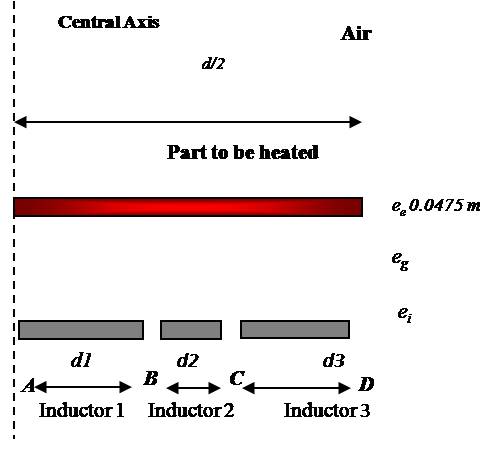 | Figure 2. Model design |
•Part Pan| Table 1. the initial shape of the Coil |
| | Characteristics | Symbols | Dimensions | | Inductor1 | d1 | 0.0175 m | | Inductor2 | d2 | 0.0073 m | | Inductor3 | d3 | 0.0126 m | | Thickness (Exciting coils) | ee | 0.0004 m | | Thickness (Pan-Exciting coils) | eg | 0.0006 m | | Distance A | A | 0.0100 m | | Distance B | B | 0.0208 m | | Distance C | C | 0.0218 m | | Distance D | D | 0.0005 m |
|
|
•Part Exciting Coils| Table 2. the initial shape of the pan |
| | Characteristics | Symbols | Dimensions | | Pan | d/2 | 0.0950 m | | Thickness | ei | 0.0012m |
|
|
 | Figure 3. Variation of the Module potential vector A |
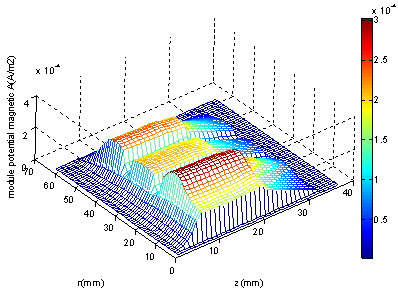 | Figure 4. Variation of the module Potential vector in the plan (r,z) |
4.1. Before Optimization
The device of figure 2 presents the three aligned inductors; working on a relatively high frequency: F = 30000Hz. This system is fed by a current of amplitude I = 15 A with a current density of 5.106A/m2 and at a temperature 300 K0Figure 3: presents the radial variation of the potential module magnetic vector ‘A’.Figure 4: presents the distribution of the potential module magnetic ‘A’ in the plan (r,z).Figure 5: presents the distribution of the temperature in the plan (r,z).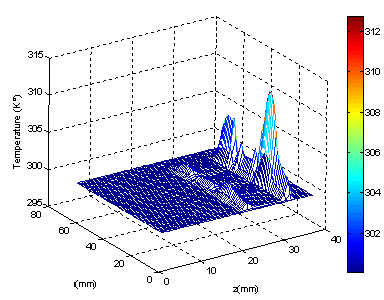 | Figure 5. Distribution of the temperature in the plan (r,z) |
4.2 Post- optimizing
In this study; we want to reach a temperature of 380 K0 in some point of thepart (piece) to be heated, by applying our method to the second optimal inductor.The working conditions are the same as those indicated above in term of frequency and operating current.Figure 6: presents the radial variation of the magnitude of the potential magnetic vector A.Figure 7: shows the distribution of the module of potential magnetic ‘A’ in plan (r,z).Figure 8: presents the distribution of the temperature in the plan (r,z).For a temperature of 300 K0; the term of potential vector A, density of the induced current and the density of the induced power are carried out, from these results are then extracted from the total power average, evaluated on all the part to heat, thus the voluminal density of average power PS to be used as source with the thermal problem If one wishes to increase the temperature in the part to be heated. ; The magnetic potential vector A augment, the density of the induced currents decreases and the induced power increases.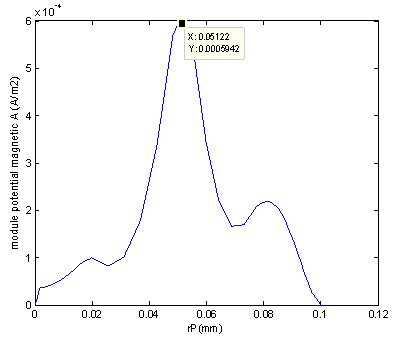 | Figure 6. Variation of the module potential vector A |
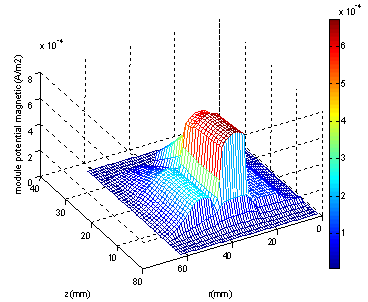 | Figure 7. variation of the module Potential vector in plan (r,z) |
 | Figure 8. Distibution of temperature in the plan (r,z) |
4. 3 ResultsTable 3. Resultats before and post Optimization
 |
| |
|
5. Conclusions
We have this work, or the use of methods of finite volumes, which allowed carrying out economic models and sufficiently precise and these resulted from our model in permanent mode which do not attain the point of curie.In addition the method of optimization chooses; who present a good simplicity of the mathematical model and easly implemented, but that remains that the temperature desire is not attained to 100 %. In prospect; and in order to obtain a whole vision on cooking by induction: to raise the number of the inductors A conclusion section is not required. Although a conclusion may review the main points of the paper, do not replicate the abstract as the conclusion. A conclusion might elaborate on the importance of the work or suggests applications and extensions.List of Symbols
References
| [1] | M. FELICHI, ‘‘ La Modélisation Numérique des Phénomènes Couplés ”, Congres International, ‘‘L’Induction dans les Procédés Industriels ”, Paris, France, Mai 1997 |
| [2] | K. SRAIRI, M. FELIACHI ‘‘Numerical Coupling Modes for Analyzing Dynamic Behaviors of Electromagnetic Actuators”, IEEE transaction on magnetics, Vol.34, No.5, September 1998 |
| [3] | BELLMAN.R.E, KALABA.R.E ‘’Dynamic programming, invariant imbedding and quasilinearization: Comparisons and Interconnections, Computing Methods in Optimisation Problems ’’ Edited by A.Balakrishnan and L. Neustadt, Academic Press, New York, 1964. |
| [4] | JIN-KYU BYUN, KYUNG CHOI ‘’ Optimal Design Procedure for a Practical Induction Heating Cooker”, IEEE transaction on magnetics, Vol.36, No.4, Juillet200 |
| [5] | JIN-KYU BYUN, KYUNG CHOI, SONG-YHAHN ‘’ Optimal Temperature Control for Induction Heating Devices Using Physical and Geometrical Design Sensitivity”, IEEE transaction on magnetics, Vol.33, No.5, September 1998 |
| [6] | BRUNO SARENI ‘’ Méthodes d’Optimisation Multimodales Associées à la Modélisation Numérique en Electroma- gnétisme’’ Thèse de Doctorat, L’écol Centrale de Lyon 1992 |
| [7] | L.ALLOUI ‘’ Modélisation tridimensionnelle par la méthodes des volumes finis phénomènes Eletromagnetiques et thermiques couplées dans les dispositifs de chauffage par induction ‘’, Thèse de magister, Université Biskra- Algérie, 2003 |
| [8] | FRANCOIS BAY, YANN FAVENNAC ET VALERIE LABBE ‘’ Un exemple de couplage électromagnetique- thermique-mecanique: la modélisation numérique du chauffage par induction ‘’, 16 éme congrès français de mécanique, septembre 2003, Nice. JASE |














 Abstract
Abstract Reference
Reference Full-Text PDF
Full-Text PDF Full-Text HTML
Full-Text HTML